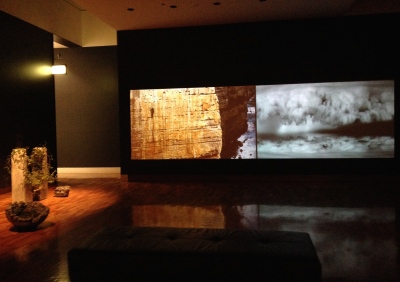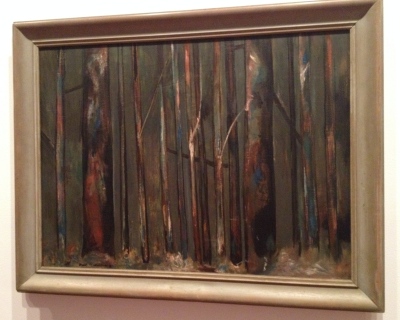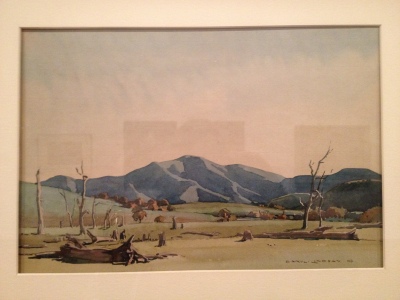I recently visited the Ian Potter Museum of Art at the University of Melbourne and was prompted to look beyond the impact of climate change on humans and to consider the plight of nature itself.

On the top floor was the Nature/Revelation exhibition that forms part of the Climarte Festival (Art + Climate = Change) of which the uni is a ‘Principal Knowledge Partner’.
It featured works by Australian and international artists that aimed to make visitors feel at one with nature and emphasised both the ‘mortality and continuity of life’.
The description of the exhibition advocated a radical positive shift in how we deal with climate change – as a modest adjustment to established systems will not ‘deliver nature from ecological crisis’.

Below this, on the first floor, was a roomful of 19th and 20th century Australian landscape paintings and more rooms containing an odd collection of objects that were meant to symbolise aspects of history that have now ‘become silent’.
I couldn’t help but wonder what had happened to the landscapes in the ‘Weird melancholy’ exhibition since they were painted or photographed.
And what does the future hold for them if climate change continues unabated?

For example:
- Did the trees that Fred Williams painted in Sherbrook Forest escape land clearing, bushfire, drought and other hazards long enough to become giants like the Californian Redwoods photographed by Ansel Adams?


Or did they succumb and now exist in a denuded landscape full of dead trunks and soil at risk of erosion?

- Was the small nimbus cloud in this room (representing the domination of humans over the natural environment) ever allowed outside to play with other clouds and become part of a huge weather system as nature intended?


- Could increased runoff from more frequent intense storms cause so much erosion in this Australian landscape that this watercourse one day becomes a mighty river weaving through a valley or perhaps even a deep canyon?



- Could the incessant pounding of the ocean waves on this cliff gradually wear it down and undermine the foundations on which structures such as the Cape Schanck lighthouse depend?


- Do these plants and moss have the power to break apart the man-made slag pots into pebbles and sand as they have for millennia or will the massive concrete and steel structures that we build litter the earth’s surface for ever more?

- And what of the man clinging precariously to this rugged cliff face? Will he tame the rock by transforming it into a massive sculpture or will nature fight back before he is finished?
 Perhaps it is already too late to change the course of our climatic evolution (or devolution)?
Perhaps it is already too late to change the course of our climatic evolution (or devolution)?
 It is certainly too late to help this dugong foetus that will never have the chance to become a majestic (but fairly strange looking) adult marine mammal – unlike the huge (also strange looking) sperm whale that covered an entire wall in one room.
It is certainly too late to help this dugong foetus that will never have the chance to become a majestic (but fairly strange looking) adult marine mammal – unlike the huge (also strange looking) sperm whale that covered an entire wall in one room.
 And spare a thought for the stone spinning around in this short video. It will never have the chance to grow up to be a large boulder in the wild.
And spare a thought for the stone spinning around in this short video. It will never have the chance to grow up to be a large boulder in the wild.
 Despite its small size, the Nature/Revelation exhibition was quite profound and thought provoking – but not necessarily in the way that the curator intended.
Despite its small size, the Nature/Revelation exhibition was quite profound and thought provoking – but not necessarily in the way that the curator intended.
Its impact was greatly enhanced by the other exhibitions at the gallery in achieving what it set out to do – to prove that art has the power to ‘stimulate individuals both intellectually and emotionally in the face of current environmental issues’ and that ‘nature can provoke a range of associations – both fantastical and grounded’.
*******************
(For a more complete review of the ‘Nature/Revelation’ exhibition, to watch some of the videos, and to look into the eye of a sperm whale – I strongly recommend checking out Dr Marcus Bunyan’s post (here).)
The ‘Nature/Revelation‘ exhibition runs until 5 July 2015 and ‘Weird melancholy: The Australian gothic‘ until 9 August 2015. Other current exhibitions include antiquities from the Vizard collection and modern art by Australian and New Zealand artists from the Wesfarmers collection. Free entry.
*******************
Photo credits – (all taken by Pip Marks June 2015 with permission from the Ian Potter Museum of Art)
- Ian Potter Museum of Art. Exterior
- View of ‘Nature/Revelation’ exhibition including David Haines ‘Day & Night’
- Gabriel Orozco ‘Boulder hand’ 2012 (still from video)
- Jamie North ‘Hemispherical object 1’ 2013’
- Fred Williams ‘Sherbrook Forest’ 1959
- Ansel Adams ‘Redwoods, Bull Creek Flat, northern California’ c.1960 (detail)
- Daryl Lindsay ‘Untitled (Howqua)’ 1926
- Berndnant Smilde ‘Nimbus D’Aspremont’ 2012’
- David Haines ‘Day & Night’ 2005-15 (still from video – cloud detail)
- John Rowell ‘Dry creek bed’ date unknown
- Ansel Adams ‘TheTetons and the Snake River, Grand Teton National Park, Wyoming’ 1942 (detail)
- Ansel Adams ‘White House ruin, Canyon de Chelly. National Monument, Arizona’ 1942 (detail)
- David Haines ‘Day & Night’ 2005-15 (still from video – waves detail)
- Kenneth Jack ‘Cape Schanck’ 1961
- David Haines ‘Day & Night’ 2005-15 (still from video – man on cliff face detail)
- Brook Andrew ‘Harvest’ 2015 (detail – Halicore australia. Dugong, late foetus)
- Jonathan Delafield Cook ‘Sperm whale (Physeter macrocephalus)’ 2013
Categories: Art
A thought provoking post!
Thanks. Nice to hear from you again!
Pleasure is mine!
As always, I love your humor — though in this case I’d say maybe ‘black humor’ –? My favorites: the little cloud (I’ve seen that image somewhere) and the stone. May they escape and live happily. And, may we somehow learn to curb our wild over-population and tread more lightly on the earth.
I was worried that those two light-hearted elements might detract from the message & nearly left them out. Nice to know they were appreciated!
Very thought-provoking.
Though things like this tend to send me off on a train of thouight they’re probably not intended to do.
They make me reflect how drastically the earth has changed, many times, before humans came along altering the climate. We’ve had ice ages and melted polar caps, alternating; we’ve had massive canyons carved into the planet and huge mountain ranges like the Himalayas grow out of nothing, Even the Mediterranean sea dried up completely for a few million years and in prehistoric tmes the earth’s atmosphere was made of poisonous gases that would have killed us humans in seconds. .
It all just makes me thing maybe we are worrying needlessly about climate change, because we’ve had much radical planet change, yet life always survives.
Even if human life doesn’t survive, I believe life will.
What do you reckon?